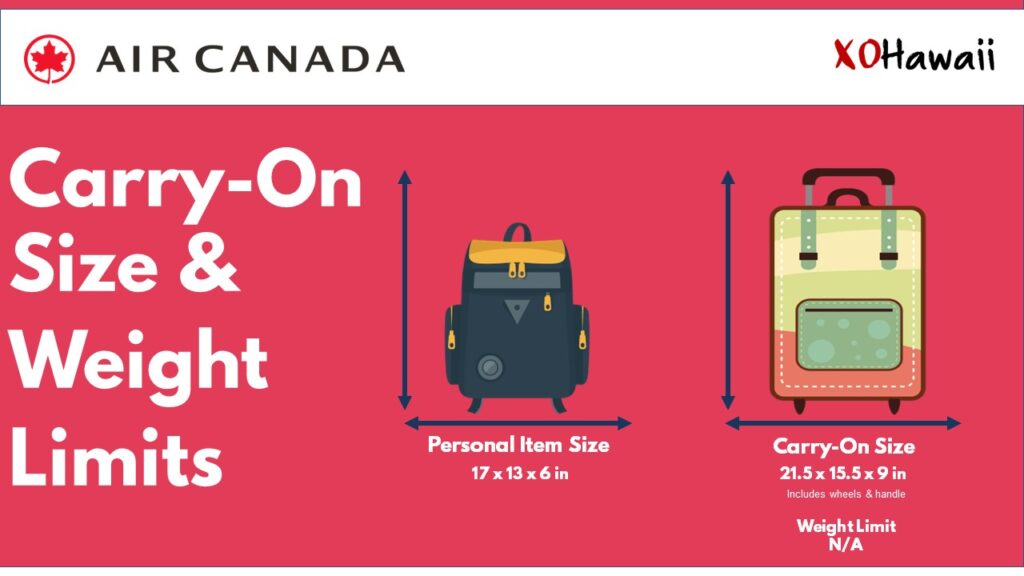If you’re planning a trip to the beautiful islands of Hawaii, there’s a good chance you’ll have a combination of checked bags and carry-on items to deal with on your flight.
If your trip includes a flight on Air Canada, you’ll need to be up to speed with Air Canada’s checked baggage and carry-on policies. Each airline’s rules are different, so don’t assume that what works for one will work for all airlines.
This article will cover the Air Canada Carry-On size and weight limits, as well as what you can bring on in terms of food, liquids, etc.
Air Canada Carry-On Baggage
Air Canada allows each passenger one personal item and one carry-on bag at no charge.

Carry-On Dimensions
Air Canada’s size requirements for a carry-on are 21.5″ x 15.5″ x 9″.
If you aren’t sure what size your carry-on is, Air Canada has “size check templates” located at their ticketing counters and (occasionally) at the departure gates.
Carry-On Weight Limit
Air Canada does not have a weight limit for your carry-on items.
Personal Item Dimensions
Air Canada requires your personal item to be no larger than 17 x 13 x 6in and the item must fit under the seat in front of you.
Personal items are generally such things as a purse, briefcase, small backpack, shopping bag, etc.
Other items you can carry on with you
In addition to your one carry-on bag and personal item, you can bring the following items on board when flying Air Canada:
- A jacket
- An umbrella
- Reading material
- Food or merchandise that you buy at the airport
- Assistive devices (such as a collapsible wheelchair, cane, crutches, medical device for prescription medications, or portable oxygen concentrator)
- A diaper bag
- A breast pump
- A camera
Air Canada Liquid Policy
The rules for carry-on liquids are set by the TSA (Transportation Security Administration) and CATSA (Canadian Air Transport Security Authority), not by Air Canada.
It’s also important to note that the rules for bringing a “liquid” in your carry-on bag are different from the rules that govern what you can bring in your checked luggage. Liquids in a carry-on bag must be 3.4 ounces or smaller and fit in a 1 quart-sized container. Anything larger must be placed in your checked luggage.
Here’s a video from the TSA to help illustrate this:
Exceptions to this rule are certain medications and baby food/child nourishment.
Carry-On Food Restrictions
Air Canada follows the rules stated by the TSA regarding what type of food you can and cannot bring on the plane.
The general rule is “If you can spill it, spread it, spray it, pump it, or pour it, then it’s considered a liquid or gel”.
This means things like yogurt, soup, jelly, and spreadable items like nut butter, cream cheese, and hummus are considered liquids and cannot be brought through security unless they are in a container of fewer than 3.4 ounces.
Prohibited and Restricted Items
There are certain items that are considered dangerous and classified as hazardous goods. These items are prohibited from your carry-on and checked bag on all flights.
Hazardous materials include, but are not limited to Explosives, Gases, Flammable Liquids and Solids, Oxidizers, Toxic and Infectious Materials, Radioactive Materials, Corrosives, and many other items that can endanger the traveling public when not handled correctly.
The rules for restricted items are not specific to Air Canada. The Federal Aviation Administration and the Canadian Air Transport Security Authority mandate them.
Here’s a video from the FAA to help illustrate this:
The Transportation Security Administration also has rules on “prohibited items” that pose a security threat. Though they sometimes overlap, the TSA security rules are separate from the FAA dangerous goods safety rules; go to the TSA Prohibited Items web page.
A complete list can be found on the FAA, CATSA, and TSA websites.
Please note, this is just a listing of common dangerous goods; if you don’t see your item here it doesn’t mean it’s allowed in baggage. When in doubt, leave it out!
Summary
Here is a link to Air Canada Carry-On page to make sure you have the most up-to-date information regarding what you can and cannot bring on the plane.


 United Airlines Carry-On Policy: Rules and Restrictions
United Airlines Carry-On Policy: Rules and Restrictions